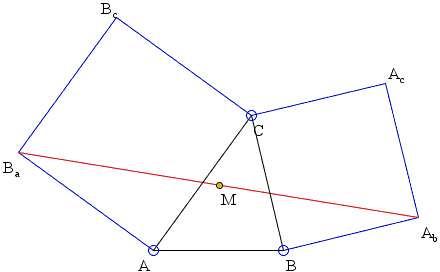An Elementary Proof of Bottema's Theorem
Consider a configuration of two squares ACBcBa and BCAcAb with a common vertex C.

Bottema's theorem claims that the midpoint M of the segment AbBa is independent of C.
Proof
Let's drop perpendiculars BaU, MW, AbV, and CZ onto AB.

MW is the midline of trapezoid BaUVAb so that
MW = (BaU + AbV) / 2.
Further, since ∠BaAC is right, angles BaAU and CAZ are complementary which makes right triangles BaAU and ACZ equal, implying
BaU = AZ.
Similarly,
AbV = BZ.
Taking all three identities into account shows that
MW = (BaU + AbV) / 2 = (AZ + BZ) / 2 = AB/2 = AW,
independent of C. (The proof also shows that M is the center of the square formed on AB upwards.)
Note: there is a dynamic illustration of the proof that makes it entirely obvious.
Reference
- A. Shriki, Back To Treasure Island, MathematicS Teacher, Vol. 104, No. 9 (May 2011), 658-664
Bottema's Theorem
- Bottema's Theorem
- An Elementary Proof of Bottema's Theorem
- Bottema's Theorem - Proof Without Words
- On Bottema's Shoulders
- On Bottema's Shoulders II
- On Bottema's Shoulders with a Ladder
- Friendly Kiepert's Perspectors
- Bottema Shatters Japan's Seclusion
- Rotations in Disguise
- Four Hinged Squares
- Four Hinged Squares, Solution with Complex Numbers
- Pythagoras' from Bottema's
- A Degenerate Case of Bottema's Configuration
- Properties of Flank Triangles
- Analytic Proof of Bottema's Theorem
- Yet Another Generalization of Bottema's Theorem
- Bottema with a Product of Rotations
- Bottema with Similar Triangles
- Bottema in Three Rotations
- Bottema's Point Sibling
![]()
|Contact| |Front page| |Contents| |Geometry|
Copyright © 1996-2018 Alexander Bogomolny73500396
